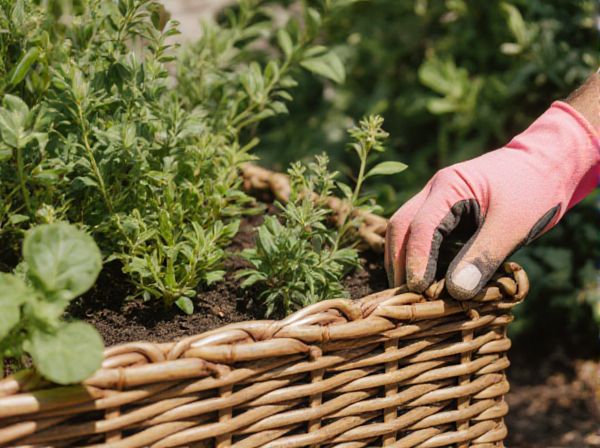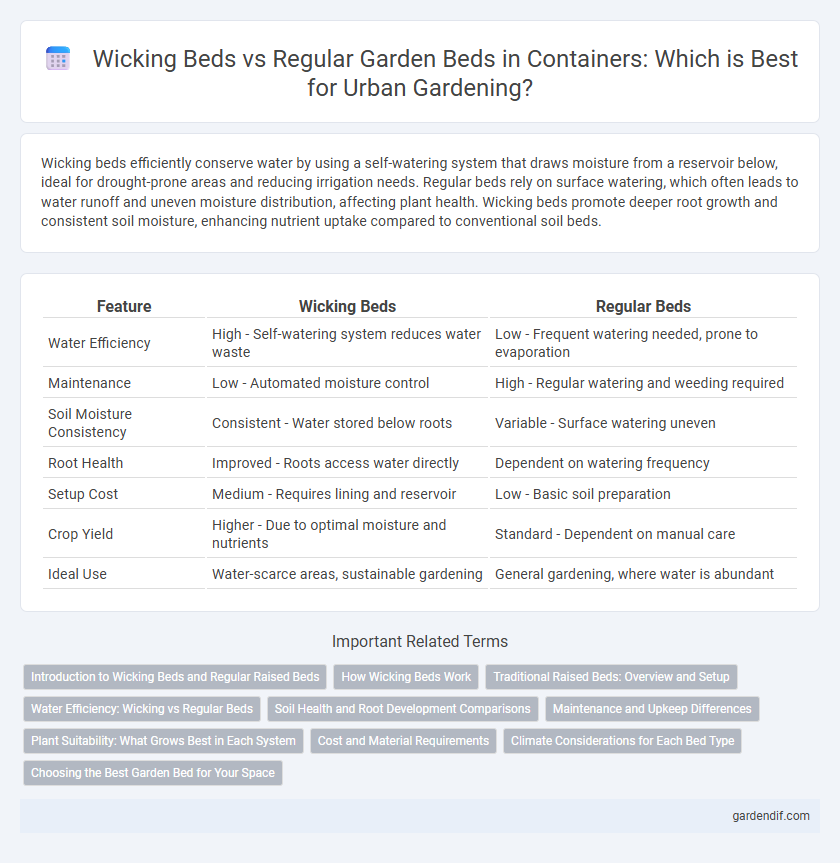
Wicking beds vs regular beds Illustration
Wicking beds efficiently conserve water by using a self-watering system that draws moisture from a reservoir below, ideal for drought-prone areas and reducing irrigation needs. Regular beds rely on surface watering, which often leads to water runoff and uneven moisture distribution, affecting plant health. Wicking beds promote deeper root growth and consistent soil moisture, enhancing nutrient uptake compared to conventional soil beds.
Table of Comparison
| Feature | Wicking Beds | Regular Beds |
|---|---|---|
| Water Efficiency | High - Self-watering system reduces water waste | Low - Frequent watering needed, prone to evaporation |
| Maintenance | Low - Automated moisture control | High - Regular watering and weeding required |
| Soil Moisture Consistency | Consistent - Water stored below roots | Variable - Surface watering uneven |
| Root Health | Improved - Roots access water directly | Dependent on watering frequency |
| Setup Cost | Medium - Requires lining and reservoir | Low - Basic soil preparation |
| Crop Yield | Higher - Due to optimal moisture and nutrients | Standard - Dependent on manual care |
| Ideal Use | Water-scarce areas, sustainable gardening | General gardening, where water is abundant |
Introduction to Wicking Beds and Regular Raised Beds
Wicking beds use a water reservoir beneath the soil to deliver moisture directly to plant roots through capillary action, promoting efficient water usage and consistent hydration. Regular raised beds rely on surface watering and drainage, which can lead to uneven moisture distribution and increased water evaporation. The design of wicking beds reduces the need for frequent watering and supports healthier plant growth compared to traditional raised bed methods.
How Wicking Beds Work
Wicking beds operate through a self-watering mechanism where water reservoirs at the base slowly deliver moisture to plant roots via capillary action, ensuring consistent hydration. This system reduces water wastage by minimizing evaporation and runoff compared to regular beds that rely on surface watering. The efficiency of wicking beds supports healthy plant growth with less frequent watering, making them ideal for container gardening and drought-prone areas.
Traditional Raised Beds: Overview and Setup
Traditional raised beds are constructed by elevating soil above ground level using wooden, stone, or metal frames, promoting better drainage and root growth compared to wicking beds. Unlike wicking beds that incorporate a water reservoir to provide moisture from below, traditional raised beds rely on surface watering and soil composition for moisture retention. They are easier to set up with standard garden tools and materials, making them a popular choice for container gardening and small-scale vegetable cultivation.
Water Efficiency: Wicking vs Regular Beds
Wicking beds optimize water efficiency by delivering moisture directly to plant roots through a self-watering reservoir, reducing water loss due to evaporation and runoff. Regular beds often require frequent surface watering, leading to higher water consumption and potential nutrient leaching. This efficient water delivery system in wicking beds can reduce water usage by up to 50% compared to traditional gardening methods.
Soil Health and Root Development Comparisons
Wicking beds maintain consistent moisture levels by delivering water directly to the root zone, promoting healthier soil microbial activity and enhanced nutrient availability compared to regular beds, which often experience uneven watering and soil compaction. The improved aeration and moisture balance in wicking beds support stronger root development, leading to more resilient and productive plants. In contrast, regular beds are more prone to drying out or waterlogging, which can stress roots and degrade soil structure over time.
Maintenance and Upkeep Differences
Wicking beds require less frequent watering and minimal maintenance due to their self-watering design, which reduces water waste and maintains consistent soil moisture. Regular beds demand more frequent watering and more attention to soil management, such as mulching and weeding, to maintain moisture and fertility. The reservoir system in wicking beds minimizes soil disturbance, whereas regular beds often need frequent soil aeration and replenishing nutrients.
Plant Suitability: What Grows Best in Each System
Wicking beds excel in growing water-loving plants like tomatoes, cucumbers, and leafy greens due to their consistent moisture supply, while regular beds suit drought-tolerant crops such as root vegetables and herbs that prefer well-drained soil. Plants with shallow root systems thrive in wicking beds, benefiting from the self-watering mechanism, whereas deep-rooted plants perform better in regular beds with loose, aerated soil. Understanding plant water requirements and root depth is crucial for choosing the appropriate bed system to maximize growth and yield.
Cost and Material Requirements
Wicking beds typically require an initial investment in components such as a water reservoir liner, wicking material like sand or felt, and a durable container, which can increase upfront costs compared to regular beds made from simple soil and basic framing materials. Regular beds often utilize readily available materials like untreated wood or metal frames, making them more affordable in terms of material requirements but potentially demanding more frequent watering and maintenance. The long-term water efficiency of wicking beds can offset their higher initial material costs by reducing irrigation expenses and conserving water resources.
Climate Considerations for Each Bed Type
Wicking beds offer superior water retention and reduced evaporation, making them ideal for arid and drought-prone climates by maintaining consistent moisture levels. Regular beds, relying on traditional irrigation, suit temperate regions with moderate rainfall where frequent watering is feasible. Climate considerations significantly impact bed choice, with wicking beds promoting sustainability in dry areas and regular beds performing well in stable, wetter environments.
Choosing the Best Garden Bed for Your Space
Wicking beds excel in water efficiency by using a self-watering system that reduces evaporation and runoff, making them ideal for arid climates or limited water supply. Regular garden beds offer more flexibility in soil types and plant diversity but require more frequent watering and maintenance. Selecting the best garden bed depends on your space constraints, watering habits, and crop preferences, with wicking beds providing optimal moisture control and regular beds supporting diverse planting options.
Wicking beds vs regular beds Infographic

 gardendif.com
gardendif.com